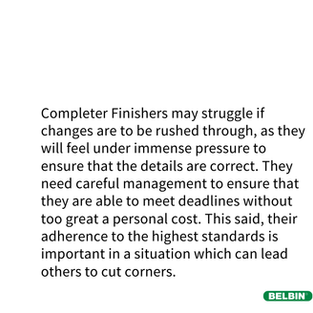Build Team Resilience with Belbin
- tal242
- Nov 23, 2020
- 4 min read
Updated: Nov 24, 2020

Build Team Resilience with Belbin
Individual and team resilience are both critical for surviving challenging times.
Team resilience is enhanced by a number of factors, foremost amongst them is in an in-depth and honest understanding of our collective strengths and weaknesses. This goes for team members and leaders alike.
The questions to ask when trying to ascertain how we may fare when ‘under the pump’ are simple enough, but without honest evidence-based answers and meaningful follow-through action, they may as well not be asked at all.
What are our strengths under pressure?
What weaknesses arise when we face threats?
How do we project strength and contain the impact of weakness?
We find time-tested behavioural diagnostics like Belbin, and carefully selected simulations, to be wonderful enablers for enhanced understanding and resilience building in teams.
Practical systems and strategies for better using our strengths and managing the associated weaknesses can then be developed by teams and leaders from observed and evidence-based insights.
It can be as simple as identifying how different people will react to a time of crisis, and then having better strategies for understanding and managing that.
There are many good reasons why airline pilots and the military will use simulators, war games and practical insights into behaviour to hone performance. They are used to better understand and experiment with both functional skills and behavioural strengths and weaknesses that will arise for individuals and teams under pressure.
Enabling people to actually ‘war-game’ their behavioural strengths and weaknesses, and their decision-making approaches, offers great benefits.
When under pressure sub-conscious reactivity in our brains contributes to our behaviour. The human brain builds up a bank of rapidly accessible references and short-cuts as to how we may respond to those ‘amygdala moments’ of fight, flight or freeze within our brain’s limbic system.
These responses to stressful situations are fast and bypass the more rational systems of the brain. Knowing in advance our individual and team indicators for when insidious factors like task and information overload, inter-personal friction and cognitive bias influence our performance will help us to get back under control more rapidly.
As a young Army Officer I remember such exercises well. The practice of team and leadership behaviours under numerous simulated conditions enabled better managed reactions to future challenges and threats. This went for individuals, small teams and larger cohorts. The old Army maxim of ‘train hard – fight easy’ comes to mind here.
The Belbin Model and its individual and team profiles measure behavioural strengths and weaknesses, and offer practical advice to safely articulate these insights.
Carefully selected exercises and activity content can then be used to draw out workplace behaviours and observe individual and team approaches in novel situations. Belbin team games or the experiential learning approaches of Sabre Corporate Development are great examples of ‘hands-on’ scenarios to accompany profile insights.
Using such approaches (providing of course that lessons learned are carried through into tangible actions) will help to build individual and team resilience to challenging times.
A 5 STEP ROADMAP FOR TEAM RESILIENCE
Anchored in our experience, we see five straightforward steps to better enabling leaders and teams to build better evidence-based understanding of their strengths and weaknesses. People can then explore and commit to real strategies for developing better performance under pressure, and better resilience to challenges and threats.
Step 1 - KNOW SELF:
Know yourself and know other team members = BELBIN INDIVIDUAL PROFILES
These can be based on Self Perception, and valuable external Observer 360-degree input.
Key Outputs: Understand yourself and others. Look at where and how we are similar and different to others. How can you contribute to team strengths? How could you add to team weaknesses if not careful? What’s your best contribution to teamwork and team decision-making?
Step 2 - KNOW THE TEAM:
Understand team strengths and weaknesses = BELBIN TEAM REPORTS
These aggregate individual reports are used to illustrate the team’s behavioural chemistry.
Key Answers / Insights: What are our potential strengths? What are our potential weaknesses? What stage of development are we in? How can we build trust? Who is best suited to make certain contributions?
Team sessions can be run internally by your own people or by us on or off-site, using robust experiential learning approaches such as Belbin Games or proven Sabre Corporate Development team building approaches.
Step 3 - KNOW YOUR WORKING RELATIONSHIPS:
Understand the one-to-one relationships we have at work = BELBIN WORKING RELATIONSHIP REPORTS
These reports are created by looking at the working chemistry between two people.
How do we handle conflict professionally and constructively? How do we disagree the right way? Can we agree on how we hold ourselves accountable and make contributions?
Step 4 - KNOW THE TEAM’S FIT WITHIN THE ORGANISATION:
Understand the culture and diversity of the larger organisation = BELBIN GROUP REPORTS
Big data on prevailing behavioural preferences across larger groups.
What’s our purpose within the organisation? What methods do we use to work towards the purpose? What’s our ultimate end state as a team, and as an organisation? What behaviours do we accept and value? What is the culture and actual lived values of our team, and do we differ from other teams within the organisation?
Step 5 - CREATE A SIMPLE TEAM CHARTER:
A Team Charter tailored by the team helps build upon insights from individual, team and working relationship reports to articulate actual responsibilities and rights within the team.
What’s our purpose? How do we behave? How do we articulate our strengths and weaknesses? Who makes what contributions to the team? What do we commit to each other, to the performance of the team and to other teams within the organisation?






















Comments